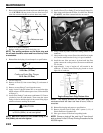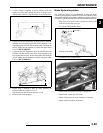
2.30
MAINTENANCE
Brake Pad Inspection
Pads should be changed when the friction material is worn to
.180” / 4.6 mm, or about the thickness of a dime.
Hose/Fitting Inspection
Check brake system hoses and fittings for cracks, deterioration,
abrasion, and leaks.Tighten any loose fittings and replace any
worn or damaged parts.
Auxiliary Brake Testing
The auxiliary brake should be checked for proper function.
1. Support the rear wheels off the ground.
2. While turning the rear wheels by hand, apply the auxiliary
foot brake. This brake should not stop the wheels from
turning until the lever is half way between its rest position
and bottoming on the footrest.
Auxiliary Brake Adjustment (Hydraulic)
Use the following procedure to inspect the hydraulic auxiliary
(foot) brake system and adjust or bleed if necessary:
First, check foot brake effectiveness by applying 50 lb.
(approx.) downward force on the pedal. The top of the pedal
should be at least 1 inch, (25.4mm) above the surface of the
footrest.
If less than one inch, two things must be examined:
Free Play:
If free play is excessive, inspect pedal, linkage, and master
cylinder for wear or damage and replace any parts as needed.
Bleeding:
If free play is correct and brake pedal travel is still excessive, air
may be trapped somewhere in the system. Bleed the hydraulic
auxiliary brake system in a conventional manner, following the
procedure outlined in Brake Chapter 9.
= In. / mm.
Brake Pad Service Limit:
.180" (4.6 mm)
Minimum
Thickness
.180” / 4.6 mm,
Auxiliary Brake
= In. / mm.
Foot Brake Freeplay:
1/8 - 1/4 inch (3.2 - 6.35 mm)
Full Height
Full
Engagement
Floor
Board Surface
Auxiliary Foot Brake Pedal
1” or
greater
1/8, to 1/4,
Free Play
Floorboard
50 lbs


















